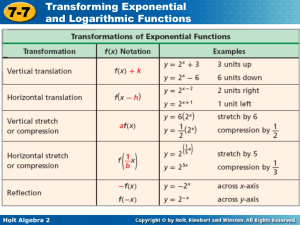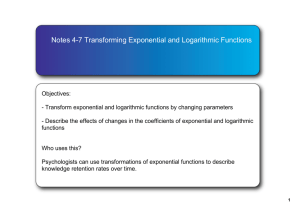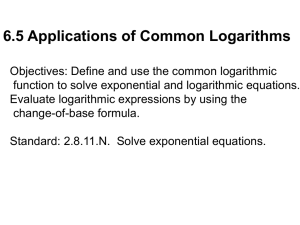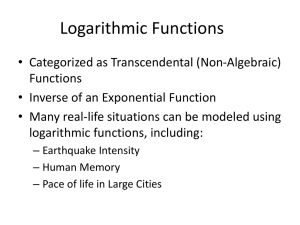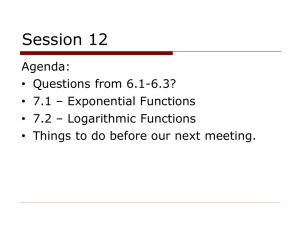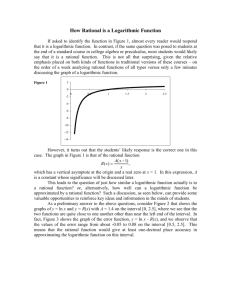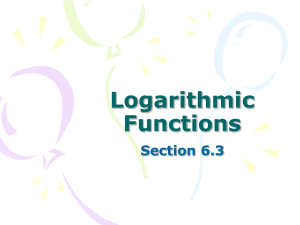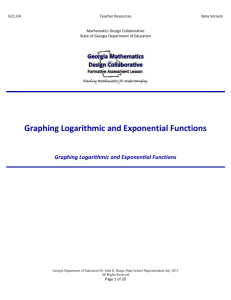7.7
advertisement
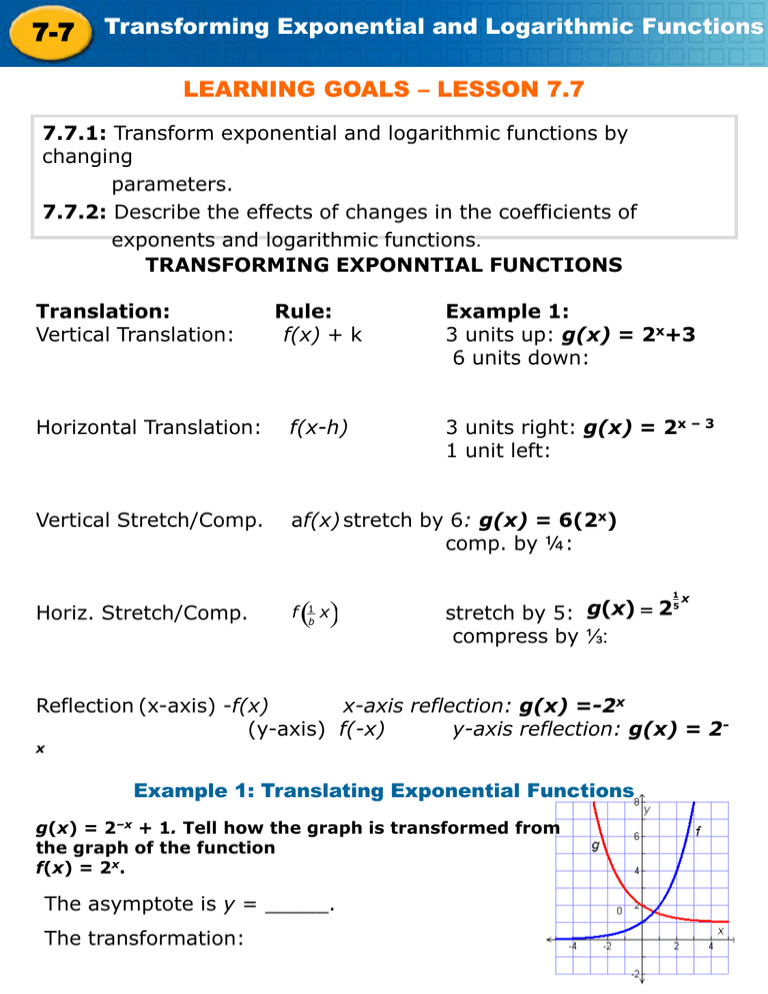
7-7 Transforming Exponential and Logarithmic Functions LEARNING GOALS – LESSON 7.7 7.7.1: Transform exponential and logarithmic functions by changing parameters. 7.7.2: Describe the effects of changes in the coefficients of exponents and logarithmic functions. TRANSFORMING EXPONNTIAL FUNCTIONS Translation: Vertical Translation: Rule: f(x) + k Example 1: 3 units up: g(x) = 2x+3 6 units down: Horizontal Translation: f(x-h) Vertical Stretch/Comp. af(x) stretch by 6: g(x) = 6(2x) comp. by ¼: Horiz. Stretch/Comp. f 1 b x 3 units right: g(x) = 2x – 3 1 unit left: 1 5 stretch by 5: g(x) 2 compress by ⅓: x Reflection (x-axis) -f(x) x-axis reflection: g(x) =-2x (y-axis) f(-x) y-axis reflection: g(x) = 2x Example 1: Translating Exponential Functions g(x) = 2–x + 1. Tell how the graph is transformed from the graph of the function f(x) = 2x. The asymptote is y = _____. The transformation: Holt Algebra 2 7-7 Transforming Exponential and Logarithmic Functions Check It Out! Example 1 f(x) = 2x – 2. Describe the asymptote. Tell how the graph is transformed from the graph of the function f(x) = 2x. The asymptote is y = ____. The transformation moves the graph: Example 2: Stretching, Compressing, and Reflecting Exponential Functions Describe how the graph is transformed from the graph of its parent function. A. g(x) = ⅔(1.5x) y-intercept: parent function: f(x) = asymptote: y = B. h(x) = e–x + 1 parent function: f(x) = ex y-intercept: e asymptote: y = CAUTION! Really is: h(x) = e(-(x-1)) Holt Algebra 2 DISTRIBUTE! 7-7 Transforming Exponential and Logarithmic Functions Check It Out! Example 2b g(x) = 2(2–x) g parent function: f(x) = f y-intercept: asymptote: y = TRANSFORMING LOGARITHMIC FUNCTIONS: Translation: Rule: Vertical Translation: f(x) + k Example: 3 units up: g(x) = log(x)+3 6 units down: Horizontal Translation: f(x-h) 2 units right: g(x) = log(x-2) 1 unit left: Vertical Stretch/Comp. af(x) stretch by 6: g(x) = 6log(x) comp. by ¼: Horiz. Stretch/Comp. f x 1 b stretch by 5: g(x) = log(⅕x) compress by ⅓: Reflection: (x-axis) -f(x) x-axis reflection: (y-axis) f(-x) y-axis reflection: g(x) = log (-x) Holt Algebra 2 g(x) = -log(x) 7-7 Transforming Exponential and Logarithmic Functions Example 3A: Transforming Logarithmic Functions Find the asymptote. Describe how the graph is transformed from the graph of its parent function. g(x) = 5 log x – 2 asymptote: x = Example 3B: Transforming Logarithmic Functions Find the asymptote. Describe how the graph is transformed from the graph of its parent function. h(x) = ln(–x + 2) asymptote: x = CAUTION! Really is: h(x) = ln(-(x-2)) DISTRIBUTE! Holt Algebra 2 7-7 Transforming Exponential and Logarithmic Functions Example 4A: Writing Transformed Functions Write each transformed function. A. f(x) = 4x is reflected across both axes and move units down. B. f(x) = ln x is compressed horizontally by a factor of ½ and moved 3 units left. CAUTION! Be sure to apply horizontal stretches and compressions last (enabling you to distribute!) C. f(x) = log x is translated 3 units left and stretched vertically by a factor of 2. Holt Algebra 2
